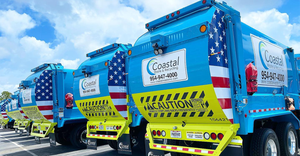LANDFILLS: Techniques Overcome Florida Landfill Erosion
November 1, 1995
Michael D. Moore
The advent of modern lined landfills has brought an assortment of challenges, some familiar and some unique to today's facilities. Consequently, some of the most effective landfill management techniques have been developed by the old engineering method - trial and error. This has been true at Florida's Citrus County Landfill, where the challenge of erosion control has been aggravating operators since the facility opened in January 1990.
Citrus County Landfill is located in west-central Florida, approximately 15 miles east of the Gulf of Mexico. The landfill's current phase, a 17-acre plastic-lined cell, is the first of six phases designed to last 30 years. With a surface elevation of 120 feet above sea level and a depth of 80 feet, the landfill is unique in Florida where shallow water tables can limit excavation depths. Side slopes, three of which are lined, are a steep 2:1 (horizontal to vertical). The unlined side contains an entrance road extending diagonally down into the cell.
Although the unlined slope was benched at intervals with ditches to control erosion, maintenance was a continuous nightmare, according to officials. Attempts to hydroseed or mulch were foiled by Florida's sizable rainstorms which washed away the seed before it could take root and formed gullies which deepened with each storm. The landfill was kept open by periodically reconstructing the slopes by dozing and excavating eroded soils from the stormwater pond.
After a catastrophic 11-inch rainfall devastated slopes that had been restored only months before, stapled sod was installed over burlap cloth on all unlined slopes. Although a costly $4 per square yard installed, the solution has required only minor maintenance since installation two years ago. Ordinarily the county pays $1.05 per square yard for installed sod; the higher costs reflect the materials and additional labor involved with the landfill's steep slopes.
When the price of sod can't be justified, operators use seed and seaweed mulch on slopes that are angled at 4:1 or flatter. Citrus County used hydrilla and water hyacinth that had been removed from nearby canals. These plants enrich the soil and facilitate seed germination by retaining moisture.
First, operators grade slopes, then spread a four-inch layer of seaweed on the ground, seeding and tilling into the top soil. A light rain or watering will cause the seed to germinate within a week. The type and quantity of seed used will vary with local conditions. If aquatic weeds are unavailable, mulch from yard waste, hay or straw can be substituted. Seed can be applied by this method at a cost of $.50 per square yard (excluding mulch).
The liners required by law also have contributed to the landfill's erosion problems. Erosion tends to occur at the edge of liners, since the synthetic liner sheds nearly 100 percent of contacted stormwater. Sheet flow concentrates at the bottom of the liner and erosion occurs where flows become concentrated on steep slopes.
When the soil layer next to the liner is eroded away, solid waste can become exposed and can contaminate the stormwater. The exposed waste also may come into contact with the liner which increases the risk of a puncture. If no other method is available to alleviate erosion damage, continual maintenance is required.
Fortunately, erosion can be controlled at the liner edge by constructing a ditch lined with plastic sheeting. Costs for manpower and equipment are approximately $4.60 per linear foot of ditch.
The ditch is formed by constructing a small earthen berm next to the liner. Next, an eight-inch wide plastic adhesive joint is used to attach the ditch liner to the landfill liner. The thickness of the selected sheeting depends upon how long the ditch will remain in place; however, a minimum thickness of 16 mil is recommended.
Use a woven, coated, three-ply membrane of low density polyethylene (LDPE) with carbon black for ultraviolet light resistance, available for approximately $1.17 per square yard for 16 mils and $1.80 per square yard for 20 mils. Drape the LDPE over the ditch bottom and over the top of the berm. Secure the loose edge of the LDPE in an anchor trench.
LDPE sheets work well when applied in 60 foot sections or longer. Joints should be overlapped at least four feet and glued with a plastic adhesive. Pressure can be applied to the adhesive joint by placing sandbags over the sheet until the adhesive dries. Sand bags placed in intervals will secure lapped joints, keep the liner in place and control flow velocity. A loose wrinkle of LDPE material at the bottom of the ditch will allow for soil settlement.
The officials at the Citrus County landfill prefer a lined ditch to sod or staked sod with burlap, because it will stand up to almost any flow velocity. Lined ditches also will provide a barrier to leachate and do not have to be watered or mowed. If sediments accumulate in a lined ditch, they can be carefully removed with a straight-edged backhoe.
Discharge from a lined ditch may be directed to a retention area using rubble rip rap to dissipate flow velocities, or the flow can be transferred to a culvert using sand bags. Sand bag end walls also can be used to erect equipment crossings over the ditch.
As these techniques demonstrate, officials in Citrus County discovered that a little creativity can go a long way in erosion control.
You May Also Like


